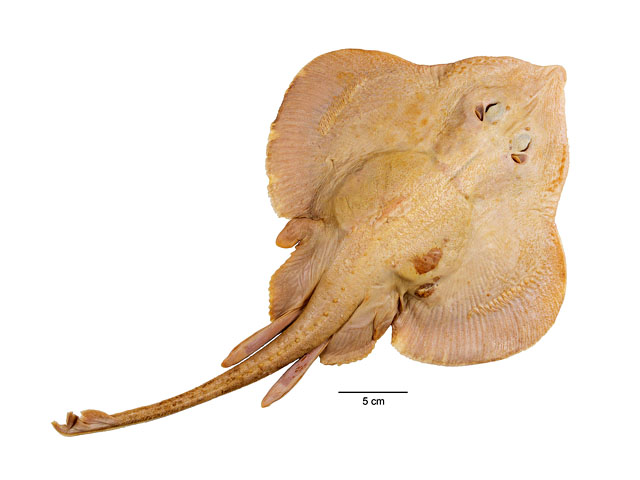|
This small species of the genus is distinguished by the following characters: disc is an evenly inverse heart-shaped with broadly rounded outer corners and with body length to mid-vent shorter than tail length from mid-vent; length of preorbital snout 10.9% and distance between first gill slits 14.1% of TL; large orbits with horizontal diameter 1.4 times interorbital width; its dorsal surface is almost completely covered with dermal denticles; the tail with large and coarse, densely set spinules as well as sharp, hooked thornlets that are not much larger than spinules; one small, blunt pre- and postorbital thorn on each side, one small nuchal thorn and one small right scapular thorn (left one not detectable, abraded), and a median row of two small median posterior trunk and 15 small median tail thorns; colour when fresh, dorsal surface plain chalk white including orbits and ventral surface grayish-white; bases of equal-sized and short but high dorsal fins confluent; the postdorsal tail section is very short, with low epichordal caudal lobe which is confluent with second dorsal fin; whitish lateral tail folds along posterior 45% of tail; tooth rows on upper jaw 31; pectoral fin radials 55-56; clasper without external pseudosiphon, the inner dorsal lobe with components slit, terminal bridge, and two clefts and the inner ventral lobe with components shield, rhipidion, pent, sentinel, spike, and dike; terminal clasper skeleton with 4 dorsal terminal cartilages, a terminal bridge, a ventral terminal, and 2 accessory terminal cartilages; anterior cranial fontanelle with clear-cut contour all around and extending about one third into rostral shaft length; subquadratic scapulocoracoid, the rear corner sharply marked, large oval anterior fenestra without anterior bridge, one moderately large, oval postdorsal and postventral fenestra, respectively; pelvic girdle with massive ischiopubic bar with nearly straight anterior and deeply concave posterior contour; prepelvic processes are short, solid, conical, and somewhat inclined outwards, their length 1.9 times median thickness of ischiopubic bar (Ref. 96993). |

